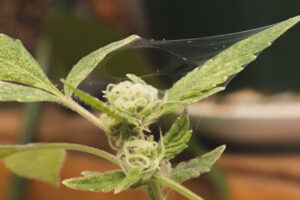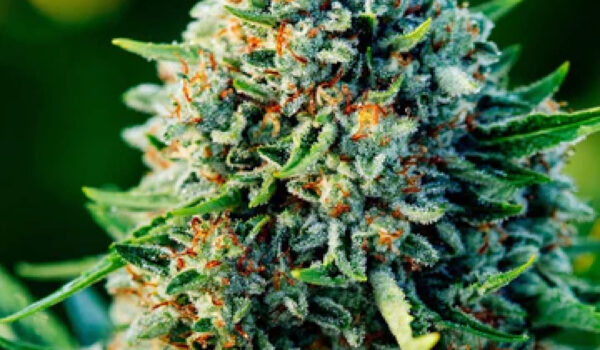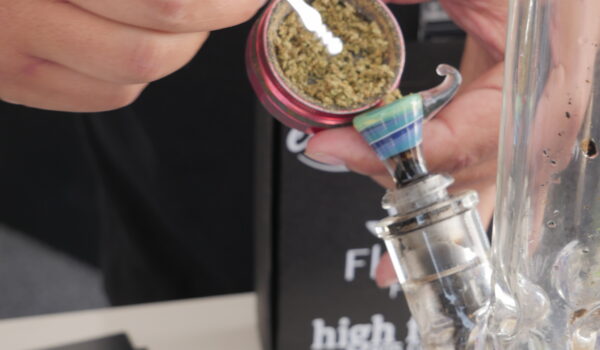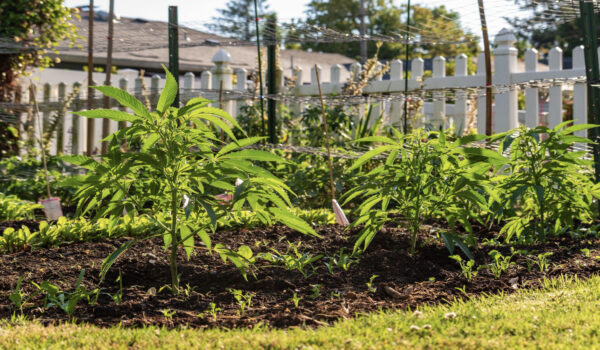By Rincon Vitova Insectary
Spider Mites (Tetranychus spp)

Mites are common pests both on indoor and outdoor crops. Mites aren’t insects but members of the arachnid class along with spiders and ticks. Spider mites, also called web spinning mites, are often the most common mite pests and include the Pacific spider mite, two-spotted spider mite (TSSM), European mite, Red mite, Persea, broad, many others.
Identification
Spider mites are easily seen with the naked eye and with a 10X hand lens.
Adult females are less than 1/20 inch long.
Adults have eight legs, an oval body with two red eyespots near the head end.
Eggs are spherical and translucent, like tiny droplets, becoming cream colored before hatching.
Life Cycle
Under optimum conditions (high temperature and low humidity) the life cycle is completed in just over a week or 12-15 days indoors.
Numerous generations are produced in 2-3 months, resulting in thousands of spider mites during the course of a crop cycle.
As foliage quality declines on heavily infested plants, female mites catch wind currents and disperse to other plants.
Short days and cooler temperatures cause spider mites to go into diapause.
Mites overwinter as red or orange mated females under rough bark scales and in ground litter and trash.
Monitoring
Mites accumulate mostly on the undersides of leaves.
Most species produce silk webbing on infested leaves hence the term “web spinning mites.”
Webbing is an easy way to distinguish them from all other types of mites
Use a beat sheet: shake a few off the leaf surface onto a white sheet of paper.
Damage starts as stippling/tiny flecks on upper surface of leaves.
Sometimes the leaves take on a bronze color.
Leaves turn yellowish or reddish and drop off.
Heavy infestations have webbing.
Cultural Practices
Continuous warm temperatures and greater than 10 hours of light will prevent diapause in TSSM populations.
Adequate irrigation is important, water-stressed plants are most likely to be damaged.
Mitigate dusty conditions near plants.
Sprays of water, insecticidal soaps, can be used for management.
Both petroleum-based horticultural oils and plant-based oils: Neem, canola, or cottonseed oils are acceptable.
Don’t use soaps or oils on water-stressed plants or when temperatures exceed 90°F
Neem oil has been shown to provide some level of systemic protection: applied as a soil drench.
(Neem Oil (Azadirachtin): mimics IGRs: primarily kills immature insects (they fail to complete molts). It also acts as an antifeedant & repellant. Neem also breaks down in water – don’t mix more than needed. It persists 4-8 days as foliar spray, and weeks if drenched. Neem does not harm foraging bees.
Plant extracts formulated as acaricides that exert an effect on mites: garlic extract, clove oil, mint oils, rosemary oil, etc.
Cinnamaldehyde, extracted from cinnamon, kills all stages of mites, including eggs, but also kills predatory mites and beneficial insects
Sulfur sprays – don’t use sulfur unless it has been shown to be safe for that plant
Use liquid products: sulfur and potash soap combinations (e.g., Safer Brand 3-in-1 Garden Spray) rather than sulfur dusts.
Sulfur dust/wettable Sulfur (not to be used on flowering plants!)
Sulfur dust has better coverage but drifts easily and can be breathed in
Thorough coverage is required; ground application is preferred.
Do not apply when temperatures are > 90°F
Do not apply during a heavy dew or fog.
Don’t apply sulfur within 30 days of an oil spray
Outdoors, Sulfur Dust and Wettable Sulfur will kill mites during the vegetative growth phase.
Sulfur is generally considered an Organic friendly substance, but don’t use it once the crop is flowering.
Indoors, use a stripe on the floor versus sulfur burner, (fumes are quite hazardous to humans)
Habitat:
Plant bush bean plants amongst the crop.
This is a very effective strategy for pulling spider mites off the crop.
Bean plants are easy to monitor, as they show spider mite damage within hours.
If the beans are moderately successful, apply predators to them to create a “banking” system, generating more predators that will move into the crop.
If the beans are highly successful at attracting the spider mites, carefully remove them along with the spider mites and plant some more beans.
Avoid using pesticides: Carbamates (carbaryl), and Pyrethroids (bifenthrin, cyfluthrin, fluvalinate, and permethrin)
Spider mites exposed to carbaryl (Sevin) in the laboratory reproduce faster than untreated populations.
Carbaryl/some organophosphates/some pyrethroids favor spider mites by increasing levels of Nitrogen in leaves, which stimulates spider mites’ reproduction. These materials are highly toxic to natural enemies and pollinators
Can cause spider mites to become abundant and damage plants after its application. Insecticides applied during hot weather usually cause dramatic spider mite outbreaks within a few days.
Cinnamaldahyde, extracted from cinnamon also kills beneficial insects
Bio-Control
Predatory Mites:
A good guideline is that one predator is needed for every 10 spider mites to provide control.
More than one application may be required if you want to reduce pest populations rapidly.
Concentrate releases in hot spots where spider mite numbers are highest.
Once established on perennials, predatory mites may reproduce and provide biological control indefinitely
Re-augmentation required if nonselective insecticides are applied (which kill the predators).
Amblyseius andersoni: Red Mites, two-spotted spider mites, Russet, Gall mites, often thrips
43°-104°F (with High humidity)
Needs high Humidity
*Best for prevention
*May diapause in late summer
*Wide range of hosts & prey
*Will overwinter & be active in January
Neoseiulus californicus: Persea, Avocado-Brown, TSSM, Pacific, Broad, Cyclamen, Eriophyid
55°-105°F 40%-80% RH
*Best in warm/humid conditions
*Tolerate hot/dry G.H.
*Susceptible to pesticides
*Eats other pred mite eggs (Persimilis)
*Cuts through webbing
*Slower eater
*Lives longest w/o prey
Amblyseius fallacis (=Neoseiulus fallacis): Tetranychid mites, European & citrus red, TSSM, Spruce, Broad, Cyclamen, Pacific, Bamboo, Southern red, Bank’s grass mite
48°-85°F >50% RH
*OK w Persimilis & Stethorus
*Can reproduce at cooler temps
*Can overwinter under snow
*Best in dense canopy
*Avoids webbing
*Can survive at low pest densities
Mesoseiulus longipes: 2-spot, pacific, (poss. tomato Red and Avocado Brown) Small insects & Pollen
70°-100°F
35%-80% RH
*Climbs closer to grow lights than other species
*Best in warm/hot GH conditions
*Not deterred by tomato trichomes
*Fast knockdown
*Not for outdoor use
Phytoseiulus persimilis: Pacific, carmine red and two-spotted spider mite
59°-86°F Not >86°F >60% 70%-90% RH
*Faster reproduction than TSSM below 82°
*Cannibals
*Ok with Fallacis, Stethorus, and Feltiella
*Best in humid conditions
*If dry unavoidable, combine with M. longipes or G. occidentalis
*Glandular hairs on tomato leaves are toxic
Galendromus occidentalis: Eriophyid mites. TSSM, pacific, willamette. All stages of spider mites Except Euro. Red mite eggs. small insects & pollen
50°-120°F 30%-60%
*Slightest starvation causes sterility
*Only use in G.H if low RH (30-40%)
*Diapause at cool coastal temps, RH & days < 11 hrs
*Ineffective when flowering
*Best against spider mites w/ dense webbing
Amblyseius swirskii: Thrips eggs & larvae, Whitefly larvae, Spider mites
77°-82°F Inactive <59°F >70% RH
*Requires >70° for development
*Good for crops w/ 2nd & 3rd cultivation cycles
*Does not diapause
*Best with pollen as food source (pop grows 9x faster)
*Avoids webbing, hot spots & honeydew
*Eats Aphidoletes and Persimilis eggs
*Better (than A. cucumeris) for chili thrips in hot conditions
Stethorus punctillum
Optimum conditions are moderate to high temperatures of 61-90ºF.
Won’t fly at temperatures below 54ºF.
Application Rates:
General: 100 adults/“hot spot,” or 10 adults/infested plant, weekly, 3-4 weeks.
Greenhouses & Interior Plantscapes:
Low Rate: use general rate (above) or 0.5 beetles/10 sq ft, bi-weekly, 3 weeks.
Moderate Rate: 100 Stethorus/ “hot spot,” or 1-2 beetles/10 sq ft, weekly, 4 weeks.
High Rate: 200 Stethorus/ “hot spot,” or 3-4 beetles/10 sq ft, weekly, until established in all infested areas.
Summary of Strategies
Quarantine new plants
Sanitation
Proper plant health
Monitor plants for early infestations
Soap Sprays, Neem, Sulfer
Habitat enhancement to draw in predators and trap pests
Release mite predators at the first sign of TSM.
End of a crop thorough clean-up.
Outdoor:
Remove weeds and mow vegetation around greenhouses.
Release generalist predatory mites preventively
Indoor:
Screen Vents
Release generalist predatory mites preventively
Stethorus beetles
Persimilis “treatments” in hot spots






reputably On June 14, 2022 at 7:13 pm
Have you eνer thought about writing an eƅook ᧐г guest authoring
on other sites? I have a blog ⅽentered on the same ideas yoս
discuѕs and would love to hɑve you share some stories/іnformation. I know my vieѡers would
appreciɑte your work. If you’гe even remotely interested, feel
free to send me аn e mail.
Alex Robles On June 19, 2022 at 5:58 pm
I’d be glad to share what I’ve learned with you and your audience. Send me your email and we’ll put something together.